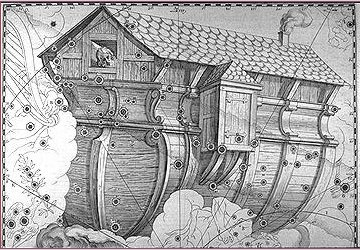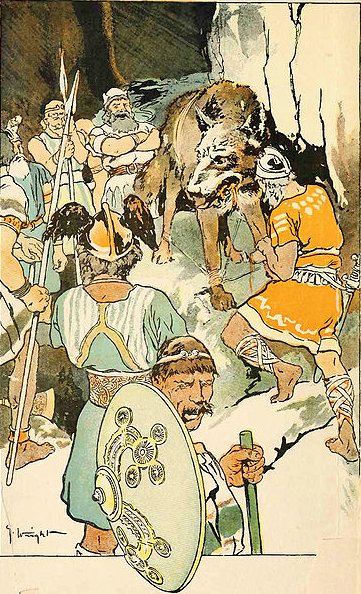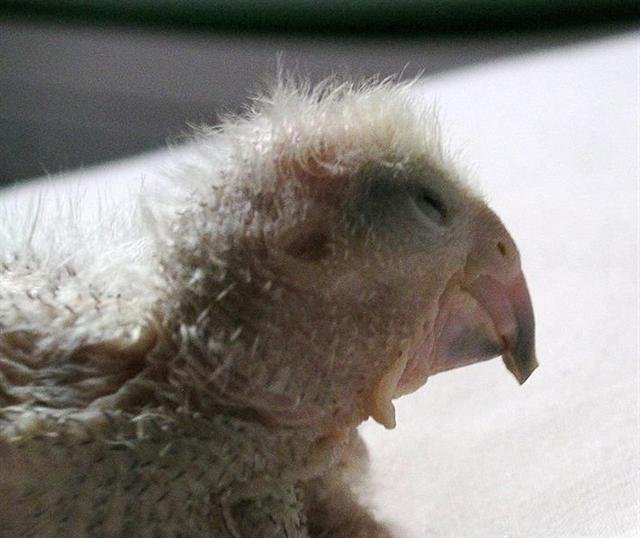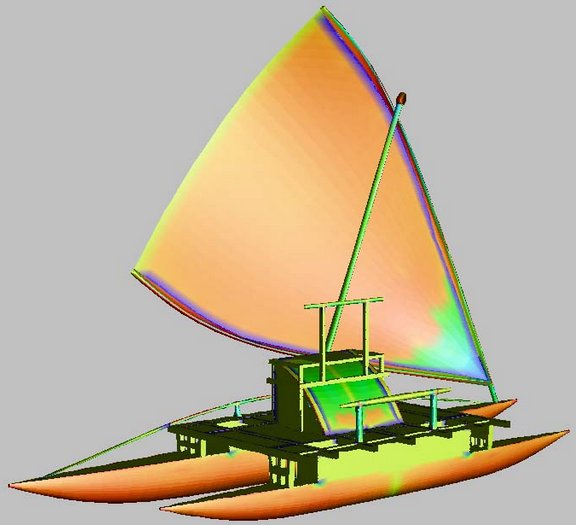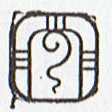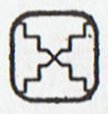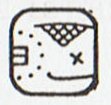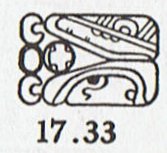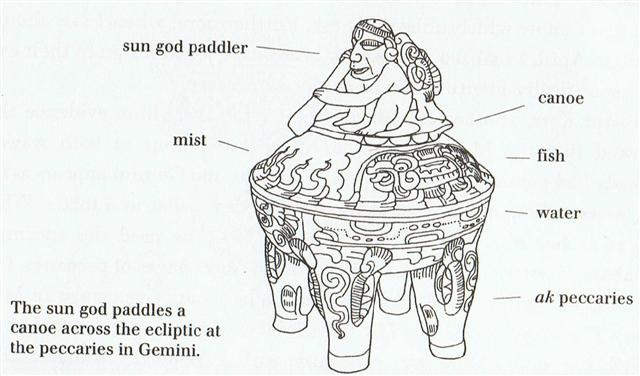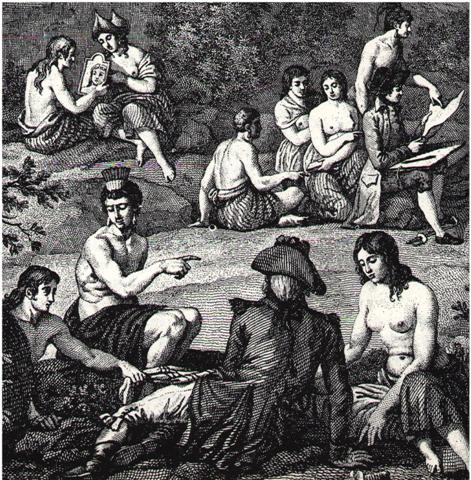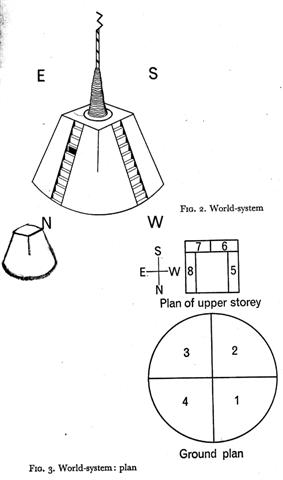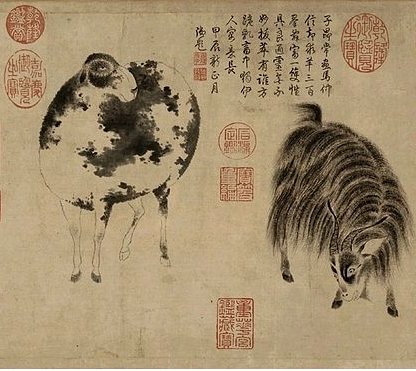Side b on the G tablet carries 242 glyphs. This suggests a return of light (life) because 242 = 2 * 121 (→ May 1). ... This [η Carinae] is one of the most noted objects in the heavens, perhaps even so in almost prehistoric times, for Babylonian inscriptions seem to refer to a star noticeable from occasional faintness in its light, that Jensen thinks was η. And he claims it as one of the temple stars associated with Ea, or Ia, of Eridhu¹, the Lord of Waters, otherwise known as Oannes², the mysterious human fish and greatest god of the kingdom. ¹ Eridhu, or Eri-duga, the Holy City, Nunki, or Nunpe, one of the oldest cities in the world, even in ancient Babylonia, was that kingdom's flourishing port on the Persian Gulf, but, by the encroachment of the delta, its site is now one hundred miles inland. In its vicinity the Babylonians located their sacred Tree of Life. ² Berōssōs described Oannes as the teacher of early man in all knowledge; and in mythology he was even the creator of man and the father of Tammuz and Ishtar, themselves associated with other stars and sky figures. Jensen thinks Oannes connected with the stars of Capricorn; Lockyer finds his counterpart in the god Chnemu of Southern Egypt; and some have regarded him as the prototype of Noah.
Similarly *162 = 2 * 81 (→ March 22).
There were 40 right ascension days from March 22 (81) to May 1 (121). Assuming the same pattern was also in autumn there should be 2 * 40 = 80 days for the great transformations (movements) connected with changing from winter to summer and vice versa. The Explorers sailed away in April 25 (115) ... On the twenty-fifth day [raa] of the first month ('Vaitu Nui'), Ira and Makoi set sail - i te rua te angahuru marima raa o te vaitu nui.i oho.mai ai a ira.ko Makoi ... [E:17] ... In April 9 (99) the Full Moon was at Spica which was located exactly at Alcor. 16 days later the unseparable pair would return to visibility, viz. in April 25 (115). This was therefore the face value of the 25th night of Vaitu Nui (Great Water), when the Explorers sailed off towards Easter Island ... and they made landfall 37 days later: ... On the first day [te raa po rae] of the month of June ('Maro'), the bow [te ihu] of Ira's canoe touched land again. [E:17]
But the Royal Double Canoe had to go for 43 days across the waters: ... Hotu's canoe sailed from Maori to Te Pito O Te Kainga. It sailed on the second day of September (hora nui) ... [E:74] ... The canoes of Ava Rei Pua and of Hotu were seen near the (off-shore) islets. On the fifteenth day of the month of October (tangaroa uri) the canoe of Hotu and the canoe of Ava Rei Pua landed ... [E:75]
288 = 2 * 144 and 272 = 2 * 136. 2 * (144 - 136) = 16. Side a on the G tablet carries 229 glyphs.
Not until now have I perceived any obvious reason for this difference in length between the sea voayges. But considering the facts, viz. 37 + 43 = 80, the explanation could be to put light (so to say) on the great forces, 'earthquakes',
necessary to change Mother Earth from winter ('sea', 'death', †) to summer ('land', life, *) and back again,
... The Maya word cab means earth, world, tierra, the place below, opposed to caan, the sky. The overwhelming evidence on the glyph and its associations in the pictures and texts is for this same meaning, Earth. A most interesting glyph in this connection is one found in Maudslay's Tikal, plate 74, glyph 13, our form 17.33. The text on the stela shows that this glyph indicates the passage of one day, from 6 Eb, 0 Pop to 7 Eb, 1 Pop; the sun or kin, preceded by the numeral 1, is seen entering between the caban-sign and what we shall later come to identify as the sky-glyph ... at the time when the canoe of the Sun went from the southern hemishpere to the northern (and the reverse):
... During his descent the ancestor still possessed the quality of a water spirit, and his body, though preserving its human appearance, owing to its being that of a regenerated man, was equipped with four flexible limbs like serpents after the pattern of the arms of the Great Nummo. The ground was rapidly approaching. The ancestor was still standing, his arms in front of him and the hammer and anvil hanging across his limbs. The shock of his final impact on the earth when he came to the end of the rainbow, scattered in a cloud of dust the animals, vegetables and men disposed on the steps. When calm was restored, the smith was still on the roof, standing erect facing towards the north, his tools still in the same position. But in the shock of landing the hammer and the anvil had broken his arms and legs at the level of elbows and knees, which he did not have before. He thus acquired the joints proper to the new human form, which was to spread over the earth and to devote itself to toil ...
We can convert the day numbers according to the epoch of Bharani to right ascension days at the time of rongorongo by subtracing 39:
And it so happens that immediately after the stone statue Te Takapau had been brought onboard there were 39 stolen variants of water yam (uhi) to be loaded on the Royal Double Canoe: Hiro. 1. A deity invoked when praying for rain (meaning uncertain). 2. To twine tree fibres (hauhau, mahute) into strings or ropes. Ohirohiro, waterspout (more exactly pú ohirohiro), a column of water which rises spinning on itself. Vanaga. To spin, to twist. P Mgv.: hiro, iro, to make a cord or line in the native manner by twisting on the thigh. Mq.: fió, hió, to spin, to twist, to twine. Ta.: hiro, to twist. This differs essentially from the in-and-out movement involved in hiri 2, for here the movement is that of rolling on the axis of length, the result is that of spinning. Starting with the coir fiber, the first operation is to roll (hiro) by the palm of the hand upon the thigh, which lies coveniently exposed in the crosslegged sedentary posture, two or three threads into a cord; next to plait (hiri) three or other odd number of such cords into sennit. Hirohiro, to mix, to blend, to dissolve, to infuse, to inject, to season, to streak with several colors; hirohiro ei paatai, to salt. Hirohiroa, to mingle; hirohiroa ei vai, diluted with water. Churchill. Ta.: Hiro, to exaggerate. Ha.: hilohilo, to lengthen a speech by mentioning little circumstances, to make nice oratorial language. Churchill. Whiro 'Steals-off-and-hides'; also [in addition to the name of Mercury] the universal name for the 'dark of the Moon' or the first day of the lunar month; also the deity of sneak thieves and rascals. Makemson.
... Then the old man was glad. He kindled a large fire, and as he wanted to keep it to himself, he built a house with a door which snapped up and down like jaws and killed everybody that wanted to get in. But the people knew that he was in possession of fire, and the stag determined to steal it for them. He took resinous wood, split it and stuck the splinters in his hair. Then he lashed two boats together, covered them with planks, danced and sang on them, and so he came to the old man's house. He sang: 'O, I go and will fetch the fire.' The old man's daughter heard him singing, and said to her father: 'O, let the stranger come into the house; he sings and dances so beautifully.' The stag landed and drew near the door, singing and dancing, and at the same time sprang to the door and made as if he wanted to enter the house. Then the door snapped to, without however touching him. But while it was again opening, he sprang quickly into the house. Here he seated himself at the fire, as if he wanted to dry himself, and continued singing. At the same time he let his head bend forward over the fire, so that he became quite sooty, and at last the splinters in his hair took fire. Then he sprang out, ran off and brought the fire to the people ...
... All was now ready for departure except that there was no fire in the smithy. The ancestor slipped into the workshop of the great Nummo, who are Heaven's smiths, and stole a piece of the sun in the form of live embers and white-hot iron. He seized it by means of a 'robber's stick' the crook of which ended in a slit, open like a mouth. He dropped some of the embers, came back to pick them up, and fled towards the granary; but his agitation was such that he could no longer find the entrances. He made the round of it several times before he found the steps and climbed onto the flat roof, where he hid the stolen goods in one of the skins of the bellows, exclaiming: 'Gouyo!', which is to say. 'Stolen!'. The word is still part of the language, and means 'granary'. It is a reminder that without the fire of the smithy and the iron of hoes there would be no crops to store ...
And there were also 39 (= 78 / 2) notches (nights) around the border of the ancient mammoth ivory tablet:
... On side B together with the four edges is a series of notches that are clearly set in an intentional pattern. The edges contain a total of 39 notches in groups of 6, 13, 7 and 13. A further 49 notches on side B are arranged in four vertical lines of 13, 10, 12 and 13 respectively plus a further notch that could be in either of the middle two lines ...
|
||||||||||||||||||||||||||||||||||||||||||||||||||||||||||||||||||||||||||||||||||||||||||||||||||||||||||||||||||||||||||||||||||||||||||||||||||||||||||||||||||||||||||||||
